Swamp Cooler Application for Building HVAC Simulation
$80.00 $40.00 Student Discount
- In this project, the movement of the cooling airflow inside a room applying a swamp cooler is investigated by ANSYS Fluent software.
- The geometry of this project is designed in ANSYS Design Modeler. The present mesh is done in ANSYS meshing. The mesh type is structured and the element number is 120250.
- the Energy equation is activated to calculate the temperature distribution inside the computational domain.
Click on Add To Cart and obtain the Geometry file, Mesh file, and a Comprehensive ANSYS Fluent Training Video.
To Order Your Project or benefit from a CFD consultation, contact our experts via email (info@mr-cfd.com), online support tab, or WhatsApp at +44 7443 197273.
There are some Free Products to check our service quality.
If you want the training video in another language instead of English, ask it via info@mr-cfd.com after you buy the product.
Description
Swamp Cooler Application for Building HVAC, ANSYS Fluent CFD Simulation Tutorial
In this project, the movement of the cooling airflow inside a room applying 3 swamp coolers is investigated using ANSYS Fluent software.
The air inside the room is cooled using 3 swamp coolers and distributed inside the room.
The geometry of this project is designed in ANSYS Design Modeler.
The mesh is carried out in ANSYS Meshing. The mesh type used for this geometry is structured, and the element number is 120250.
The velocity magnitude is 5 m/s, and the airflow temperature from the swamps equals 292 K.
Swamp Methodology
The standard k-epsilon model is exploited to solve turbulent flow equations, and the energy equation is activated to calculate the temperature distribution inside the computational domain. Also, Shell Conduction B.C is used for modeling the inner walls.
Swamp Cooler Application for Building HVAC Conclusion
Contours of pressure, velocity, temperature, etc., are obtained and presented. Temperature reduction is visible while applying swamp coolers for the room air conditioning.

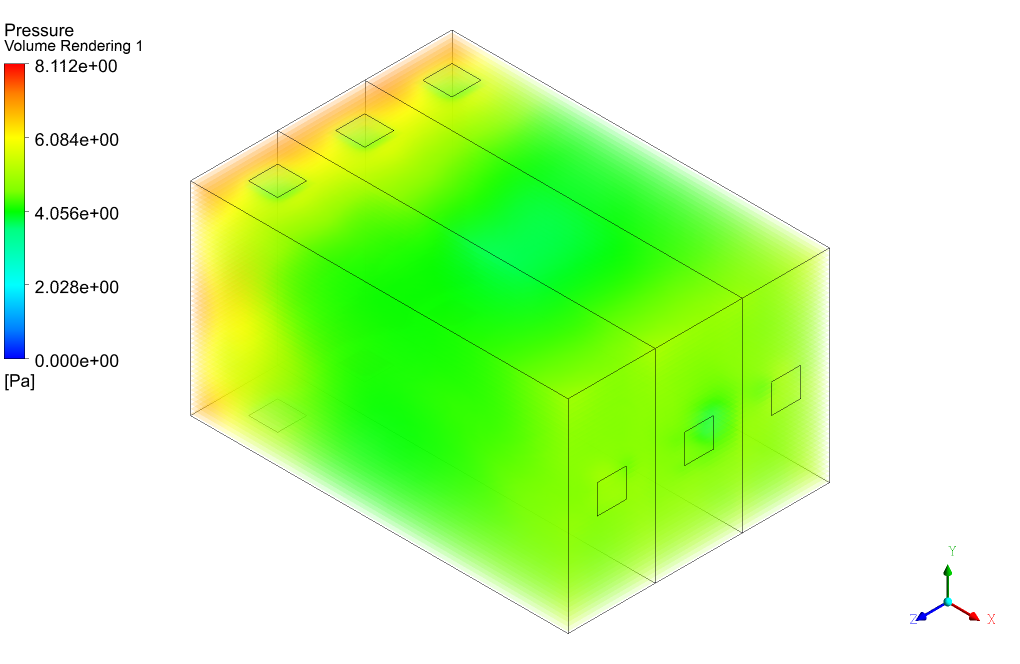
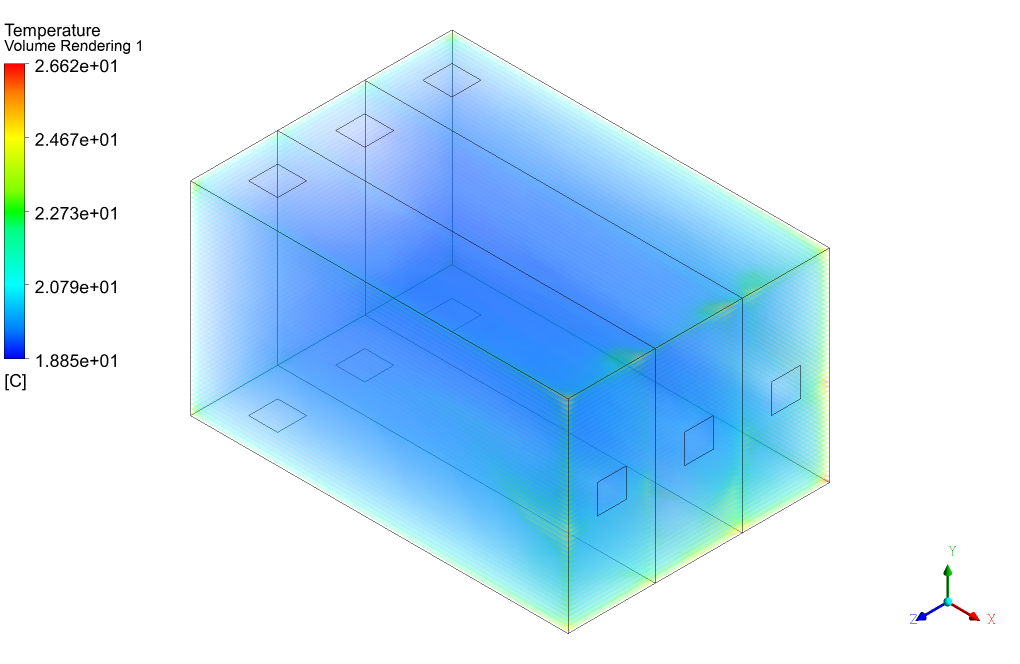

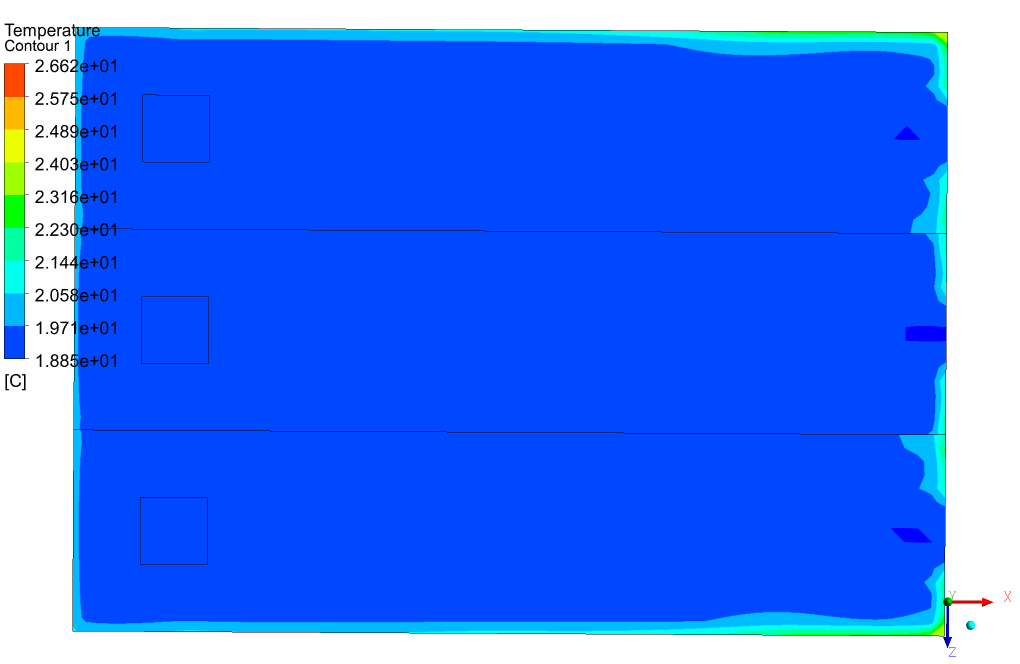
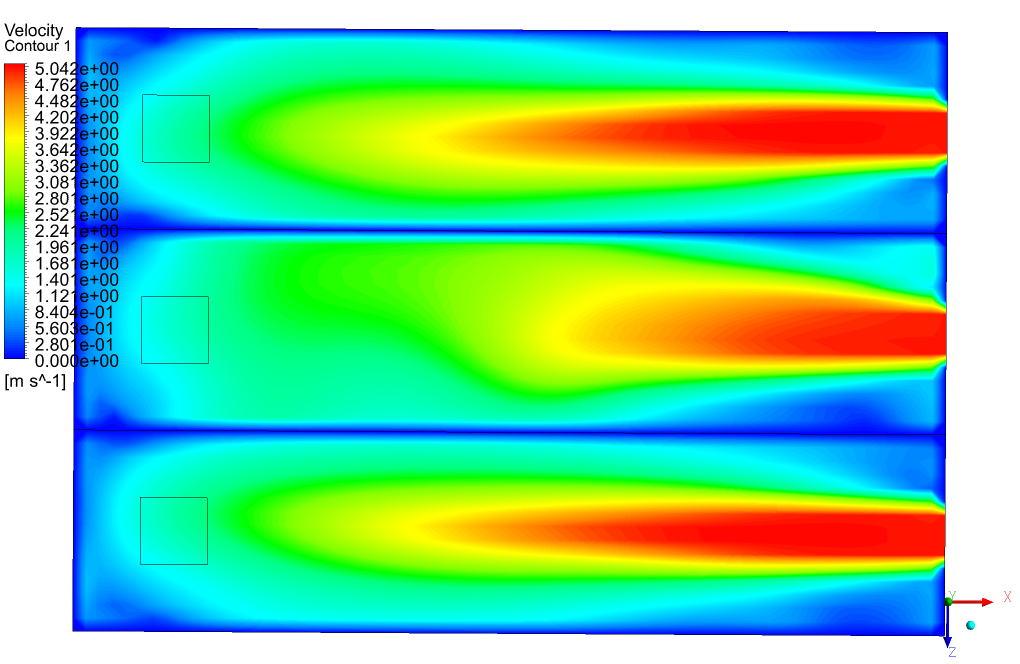
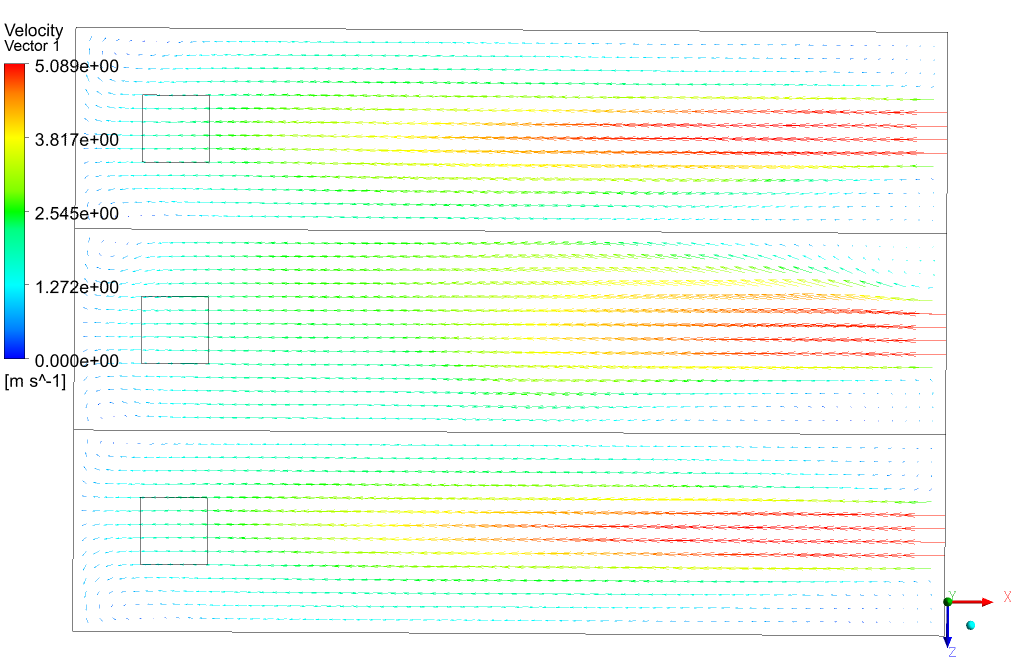
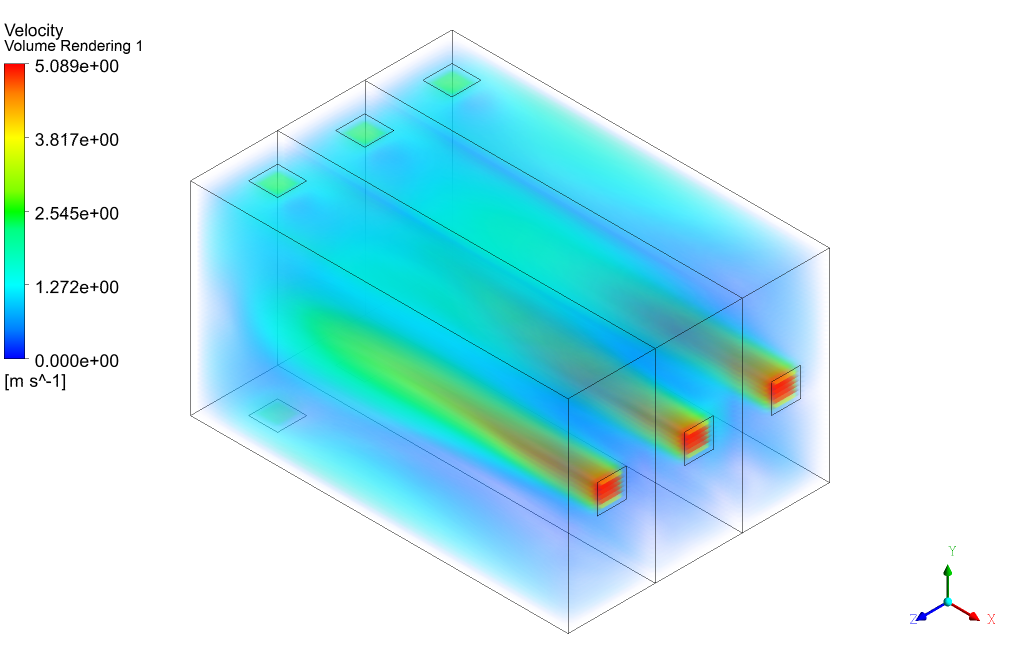
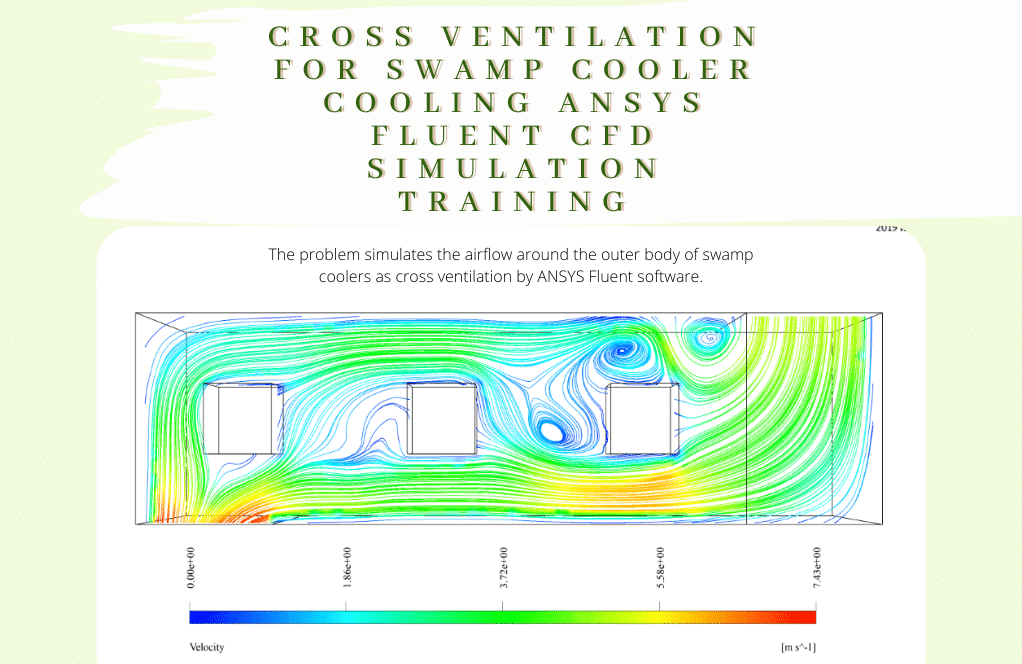

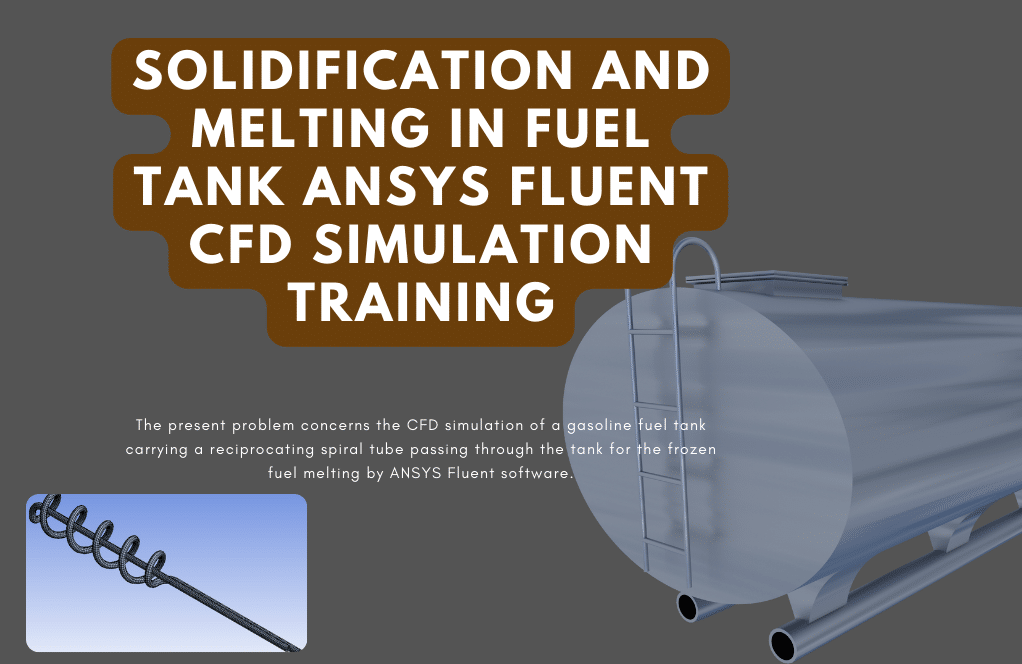
Brandi Stehr MD –
Can these simulations be used for other types of HVAC systems?
MR CFD Support –
Yes, our approach can be adapted to simulate a wide range of HVAC systems. If you have a specific system in mind, we would be happy to discuss creating a custom simulation for you.
Abbie Cummings –
How do you model the evaporative cooling process in your simulations?
MR CFD Support –
We use mathematical models to represent the physical processes involved in evaporative cooling, including heat and mass transfer. These models are then implemented in our CFD software to simulate the performance of the swamp cooler.
Yoshiko Bogisich Jr. –
I’m absolutely pleased with how this tutorial guided me through the simulation of cooling airflow using swamp coolers in a room. The step-by-step approach made it really easy to follow, and the visuals helped me understand the temperature distribution and airflow clearly!
MR CFD Support –
We appreciate your positive feedback and are delighted to hear that the tutorial met your expectations. It’s great that it facilitated your understanding of the swamp coolers’ HVAC simulation. Thanks for choosing MR CFD for your learning journey!
Prof. Shaniya Lakin –
Wonderful tutorial! The details on airflow and temperature control using swamp coolers within a room were clearly explained. I appreciate the use of the standard k-epsilon model for turbulence and shell conduction B.C for the walls had such an impact on the results.
MR CFD Support –
Thank you for your positive feedback! We’re thrilled to hear that the tutorial was helpful and the methodological choices aided in your understanding. It’s always rewarding to see our products assisting our customers effectively!
Dr. Juliana Oberbrunner III –
The swamp coolers changed the room’s air temperature significantly based on the results. Impressive CFD work balancing airflow distribution and thermal analysis.
MR CFD Support –
Thank you for your review! We’re glad you noticed the temperature reduction and the benefits of using swamp coolers for room air conditioning in our simulation. We strive for accuracy and useful results in our CFD projects.
Eden Runte –
How Can I get shock wave plot in results??
MR CFD Support –
Hi
You can go to the contours and see the contour of Mach Number, also plot velocity or Mach Number in Fluent or Post-Processing software.
Kathleen Lindgren –
The tutorial on Swamp Cooler Application for Building HVAC seemed detailed. I was truly impressed with the clear results showing the effectiveness of swamp coolers in air conditioning.
MR CFD Support –
Thank you for your positive feedback! We’re glad to hear that our tutorial was helpful and detailed, and you could clearly observe the impact of swamp coolers on room temperature. If you have further queries or need assistance with other CFD simulations, feel free to reach out.
Kevin Mann –
Could you explain more about the phenomena you’re simulating in the Building HVAC Using Swamp CFD Simulation?
MR CFD Support –
Certainly! This simulation models the airflow and temperature distribution in a building using a swamp cooler. It allows us to study and optimize the performance of HVAC systems using evaporative cooling.
Vincenzo Waters –
I’m very impressed with the detail and skills shown in the Swamp Cooler tutorial for building HVAC simulation. It was incredibly informative.
MR CFD Support –
Thank you for your positive feedback! We’re glad to hear that the tutorial met your expectations and provided you with the detailed information you needed. If you have any further questions feel free to reach out. We’re always here to help!
Alanna Bernier –
I appreciate the detailed swamp cooler HVAC simulation! It really helped me understand air movement and temperature distribution inside a room.
MR CFD Support –
We’re thrilled to hear that the swamp cooler HVAC simulation was beneficial to you! Understanding airflow and temperature control is crucial for effective room conditioning, and we’re glad our tutorial could assist. If you have any further questions or need additional guidance, don’t hesitate to reach out. Thank you for your kind words.
Johann Bradtke –
This tutorial was absolutely essential for my project on HVAC systems. Learning to simulate the movement of cooling airflow was invaluable, and the results have been super clear and useful!
MR CFD Support –
We’re thrilled to hear that our tutorial on Swamp Cooler Application for Building HVAC has played a key role in your project and that the simulation results were clear and beneficial to you. Thank you for choosing our learning products, and we appreciate your positive feedback!
Melyna Skiles –
I’ve been using MR CFD’s Swamp Cooler tutorial for my building design project, and I’m extremely pleased with the modeling results. The structured learning material helped me grasp complex HVAC concepts easily – an excellent guide for anyone working in mechanical or architectural engineering fields!
MR CFD Support –
We genuinely appreciate your positive feedback on the Swamp Cooler Application for Building HVAC tutorial! It’s great to hear that our tutorial aided in your understanding and application of HVAC systems in building design. Thank you for choosing MR CFD’s learning products, and we wish you the best in your engineering endeavors!
Nichole Rau –
An exceptional learning experience! The way the simulation incorporates multiple swamp coolers to achieve temperature reduction is intriguing and teaching the structured approach with such a detailed mesh greatly helped in visualizing HVAC possibilities.
MR CFD Support –
We’re so glad to hear you found the project informative and helpful. Your appreciation motivates us to keep providing high-quality learning materials. Thank you for your positive feedback!
Mr. Norberto Hayes –
I am really impressed with how effectively the swamp coolers have reduced the temperature in the room as shown in the simulation results. Great tutorial for understanding HVAC applications!
MR CFD Support –
We’re thrilled to hear that the tutorial was helpful and you’re satisfied with the results of the simulation. Thank you for your positive feedback!
Dariana Zboncak –
This tutorial for the Swamp Cooler Application in HVAC is excellent! Great visuals and really well-explained steps in using ANSYS Fluent. It helped me a lot in understanding the cooling effect within a room.
MR CFD Support –
Thank you for your positive feedback! We’re delighted to hear that our tutorial was helpful and clear. If you have any more questions or need further assistance, feel free to reach out. Your success is our goal!
Mr. Lucas Raynor II –
I’ve followed the tutorial for the Swamp Cooler application in my building’s HVAC system. The temperature distribution after applying the swamp coolers shows a nice cooling effect. It’s detailed and easy to follow, thank you!
MR CFD Support –
We’re thrilled to hear that you found the Swamp Cooler application tutorial detailed and easy to follow. It’s great to learn that the temperature distribution was clearly visible and met your expectations. Thank you for taking the time to provide your positive feedback!
Amy Hoppe –
Just wanted to say the tutorial was excellently put together. Following the steps for setting up the swamp cooler application made understanding the HVAC setup much easier. Thanks for the clear instructions and visuals!
MR CFD Support –
We’re thrilled to hear that you found our tutorial helpful and easy to understand! Thank you for taking the time to share your positive experience. We always aim to provide clear and comprehensive instructions. If you have any further questions or need assistance in future projects, feel free to reach out to us!
Bertram Ernser –
I’ve noticed a significant difference in my home’s comfort after setting up the swamp coolers based on the HVAC simulation guidance. The rooms feel cooler and more pleasant.
MR CFD Support –
We are thrilled to hear about your positive experience with the swamp cooler HVAC simulation and that it’s made your home more comfortable. Thank you for sharing your success!
Prof. Elva Hoeger –
After applying this tutorial, my room simulation showed a significant temperature reduction. The airflow distribution was very even, thanks to the structured mesh. Great job on explaining every step in detail!
MR CFD Support –
Thank you so much for your positive feedback! We’re thrilled to hear that our tutorial helped you achieve a significant temperature reduction in your simulation. It’s great to know the structured mesh technique provided an even airflow distribution. We appreciate your appreciation of the detailed explanations provided. If you ever have any more questions or need further assistance with your simulations, don’t hesitate to reach out. Thanks again for choosing our tutorial for your HVAC analysis!
Gerald Kutch –
I enjoyed this Swamp Cooler Application for HVAC simulation. The results helped me understand how effective swamp coolers can be for building cooling solutions. Appreciate your detailed approach!
MR CFD Support –
We’re thrilled to hear that our Swamp Cooler Application for Building HVAC simulation was beneficial to you! Thank you for your positive feedback. It’s fantastic that the detailed results gave you a clearer understanding of swamp coolers for cooling solutions. If you need further assistance in the future, please don’t hesitate to reach out.
Prof. Lance Ziemann –
This project on swamp coolers has really given me a clear understanding of HVAC applications with ANSYS. The methodology explained well how the air distribution can be studied and optimized. Great tutorial!
MR CFD Support –
Thank you for your positive feedback! We’re delighted to hear that the tutorial was effective in demonstrating the application of swamp coolers using ANSYS Fluent for HVAC simulations. If you have more questions or need further assistance with similar simulations, please feel free to reach out to us!
Jaycee Kuhic –
Wonderful product! The tutorial was clear, and the simulation ran smoothly. The results matched expected outcomes for temperature distribution.
MR CFD Support –
Thank you for the positive feedback! We’re thrilled to hear that the tutorial was helpful and that the simulation results met your expectations. If you have any more questions or need further assistance, feel free to reach out!
Nelda Koepp –
I am thrilled with how effectively the swamp coolers are modeled to distribute the cooling air in the simulation! The details on the structured mesh and the use of the k-epsilon model make this a very comprehensive HVAC analysis tool. The reduction in temperature captured in the simulation contours demonstrates the potential for energy-efficient cooling in building design. Great job on this tutorial!
MR CFD Support –
Thank you for your positive feedback! We are delighted to know that our tutorial on swamp cooler application has met your expectations and provided thorough insights into efficient HVAC system modeling. We pride ourselves on offering high-quality CFD simulation tutorials to assist in practical and energy-efficient building designs. If you have any more questions or need further assistance, don’t hesitate to get in touch!
Tomasa Gottlieb DVM –
The tutorial for this Swamp Cooler simulation was amazing! I was able to apply it smoothly to my building project.
MR CFD Support –
We are thrilled to hear that the Swamp Cooler application tutorial was helpful for your building HVAC project. Thank you for the feedback, and we wish you success in all your future simulations with ANSYS Fluent!
Alysa Jaskolski –
I enjoyed learning through the Swamp Cooler Application tutorial. It demonstrated the airflow patterns clearly and got me familiar with applying HVAC concepts in simulations.
MR CFD Support –
Thank you for your positive feedback! We’re delighted to hear that you found the Swamp Cooler Application tutorial for ANSYS Fluent helpful and that it contributed to a clear understanding of HVAC systems in simulations. We look forward to providing you with more valuable learning experiences in the future!
Mohammed Rutherford Jr. –
I am very satisfied with how the swamp cooler application was used in this HVAC project. The results for temperature distribution after applying the swamp coolers are clearly detailed and they indicate a significant temperature reduction which is essential for efficient air conditioning. Thank you for this comprehensive simulation tutorial!
MR CFD Support –
We’re thrilled to hear that our simulation tutorial for the Swamp Cooler Application in Building HVAC was helpful and met your expectations. If you have any more questions or need further assistance in the future, please don’t hesitate to ask. Thank you for your positive feedback!
Lilly Okuneva –
Fantastic resource for understanding HVAC systems with CFD! The thorough outputs of pressure, velocity, and temperature contours really helped visualize the effectiveness of swamp coolers in building air conditioning.
MR CFD Support –
Thank you for your positive feedback! We’re delighted to hear that our tutorial has been helpful in visualizing and understanding the function of HVAC systems using swamp coolers through CFD simulation. If there’s anything more you’d like to learn or further assistance you require, feel free to reach out.
Beau Fisher V –
This tutorial was just wonderful! I was able to follow along with the CFD simulation and gain a strong understanding of how swamp coolers can effectively be used for building HVAC. I particularly found the structured mesh approach and the use of the k-epsilon turbulence model incredibly insightful for my own projects. It’s great to see the temperature contours demonstrating the cooler’s impact. Excellent resource!
MR CFD Support –
Thank you for your positive feedback! We’re thrilled to hear that our tutorial on the use of swamp coolers for building HVAC was helpful for your learning and projects. It’s always great to know when the effort put into our tutorials pays off for our customers in their CFD ventures. If you have any further questions or need assistance with future simulations, feel free to reach out to MR CFD. Happy simulating!